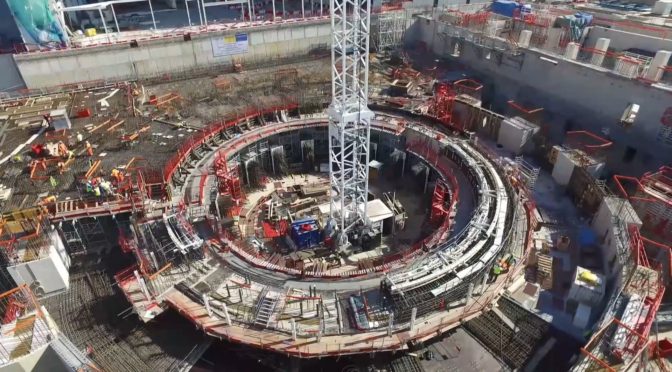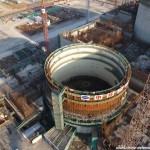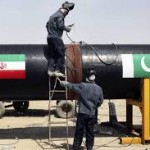
Nuclear fusion – on the way or false hope?
The last two years have seen a number of projects reporting “significant” progress being made towards the goal of developing nuclear fusion energy. This form of energy replicates the processes that drive the sun and continues to be the physicists’ ideal form of energy generation. Nevertheless, these recent developments mark but small steps on a long road to commercial operation.
The physical principals and engineering challenges
The physical principals of nuclear fusion are directly opposite to those of nuclear fission and have been understood since the 1920s. The fission process involves splitting an atom by bombarding it with a neutron, thus releasing energy. Nuclear power plants use isotopes of uranium or plutonium as the fuel. When split, these atoms release not just energy but also more neutrons that sustain the fission process in a chain reaction that, when controlled, yields a stable flow of energy.
In contrast, fusion involves fusing two hydrogen nuclei together to create helium, thereby releasing a large amount of energy, as is seen in the sun and the stars. This process commonly involves the deuterium or tritium isotopes of hydrogen and requires temperatures greater 100 million degrees centigrade when carried out on earth. At these temperatures the atoms break down into what is called “plasma”. The nuclei will fuse if the plasma is kept stable for a sufficient duration. The result is the physicists dream of infinite energy supply.
Competition between technologies
Just as the engineering challenge in fission is to contain and control the chain reaction, the challenge in the case of fusion is to contain the reaction and keep the plasma stable for a sufficient period to allow the nuclei to fuse. The commonly applied method to contain the plasma is through the use of very strong magnets, an approach that was conceptualised in the 1950s. The Tokamak concept was first developed and tested by the Soviets in the 1950s and involves containing the plasma in a donut-shaped chamber. An electric current wrapped around the donut generates the magnetic field. This concept has formed the basis for most conceptual designs and experimental facilities over the past 50 years. The next step in the development of the Tokamak approach is called DEMO, which will form an intermediate between an experimental reactor and an operating fusion power plant.
The rival, but less tested, concept is the Stellarator that has a more complex geometry. This allows it to generate a three-dimensional magnetic field which in turn facilitates control of the plasma, rather than the two-dimensional field of the Tokamak design. Whilst the Tokamak is technically simpler, the more sophisticated Stellerator has a number of advantages that could make it more attractive after further testing and development.
Competition and cooperation between countries
So attractive is the idea of commercially viable energy from nuclear fusion that it has long been a source of both competition and cooperation: competition because of the economic, and possibly political influence that would accrue to the first nation to master the technology; cooperation on account of the huge costs and uncertainties involved in the search for this holy grail.
The US and the Soviet Union were the first players, with a large number of different designs being developed in the 1970s and early 1980s, especially in the US. Thereafter Japan and the EU started developing their own designs. Since the year 2000 China, South Korea and India have joined the race and, more recently, the US has reduced funding for fusion research.
The leading experimental plants today are in the EU and China. The most complex and ambitious of these is ITER, a collaborative endeavour supported principally by the EU, and with contributions from the US, China, Russia, Japan, South Korea and India. Land clearance on the 42 hectare site in southern France began in 2007, and the first plasma is scheduled to be generated in 2025. The reactor is of Tokamak design and involves scientists from 35 nations. The total cost is currently estimated at about US$20 billion. If successful, ITER would lead to the construction of one or more DEMOs by the project members.
China has also being investing heavily in the Tokamak design, with its Experimental Advanced Superconducting Tokamak (EAST) in Anhui Province. This reactor has been operating since 2006 and made the news in November 2016 when it was announced that the plant had succeeded in creating hydrogen plasma and keeping it stable for more than one minute, a very significant achievement. This may encourage China’s government to support the successor project, the Chinese Fusion Engineering Test Reactor (CFETR). In this case, China would become the clear leader in the global race to develop fusion energy, for the key to success is as much about funds as science. Nevertheless, the Chinese initiative relies on international collaboration through both the country’s involvement in ITER and the foreign scientists working at EAST.
In the meantime, Germany had been testing its Wendelstein 7-X reactor, the world’s most advanced Stellerator. The plant was completed in 2015 and was already operating as it should the following year, generating hydrogen plasma. The aim is to achieve 30 minutes of plasma discharge by 2021. The significance of the Wendelstein 7-X lies in its proof of the Stellarator concept. Although principally a German project, the EU and the US also provide support.
Although these three projects (ITER, EAST and Wendelstein 7-X) are the ones making the headlines, projects in the UK, the US and South Korea have also made progress in the last two years.
Competition between beliefs
Behind these developments lies a more fundamental competition – a competition of beliefs. Set against the idealistic belief in the future of nuclear fusion as a source of energy are two lines of argument. The first relates to costs and alternatives. The costs of even these experimental plants is huge, and most governments today, with the exception of China, struggle to provide the required funds in a timely manner. At the same time, renewable energy and associated technologies, such as for energy storage, have been making such progress in terms of quality and cost that many people see them as forming the long-term future for energy supply, rather than fusion.
A second line of dissent comes from scientists who argue that these “significant” achievements represent only very small steps on a long path towards the development of commercially-viable, large-scale fusion energy plants. Moreover, they point out that some of the most vexing engineering challenges have yet to be solved.
Outlook
The recent announcements by China and Germany on the achievements of their experimental fusion reactors represent significant but small steps.
There are three key projects to watch. The giant European-based INTER project is due to generate plasma in 2025, assuming the funds continue to flow at the required rate. In the meantime, China may decide to raise the level of funding and move from its experimental EAST reactor to the more advanced CEFTR, which would mark a significant step towards developing a reactor that genuinely generates electricity. These initiatives apply the Tokamak concept. In contrast, Germany is pursuing the Stellarator design with its Wendelstein 7-X reactor which offers an alternative technological path.
Nevertheless, the development of commercially-viable of electricity generation through nuclear fusion is unlikely before 2050, and will require very high levels of funding. It is also possible that governments lose interest in nuclear fusion, in preference for renewable energy and other energy technologies.






